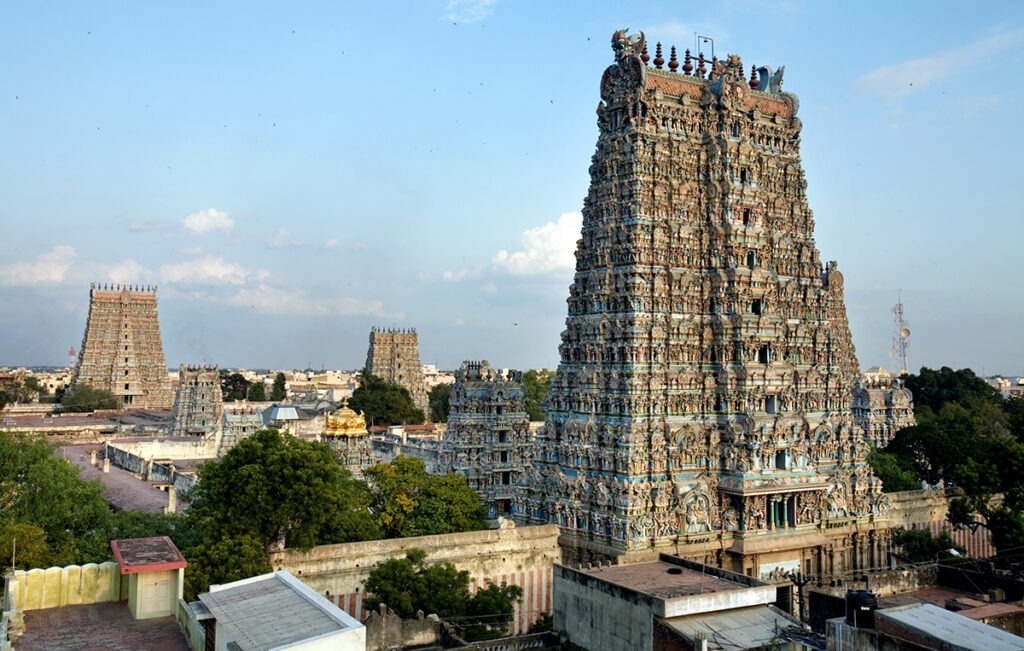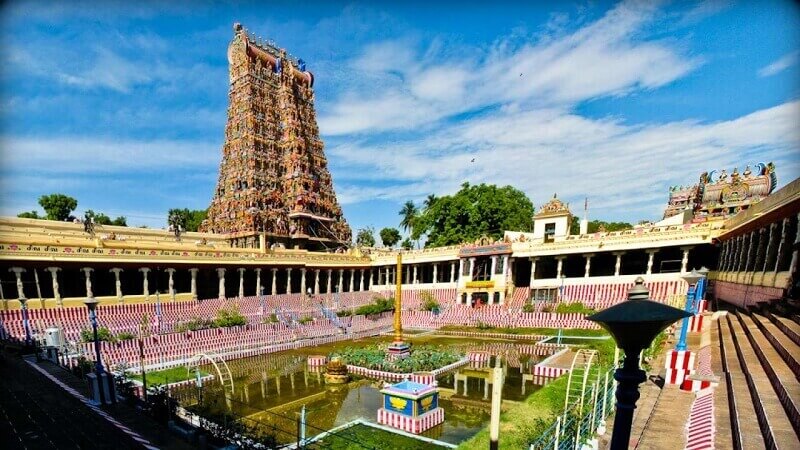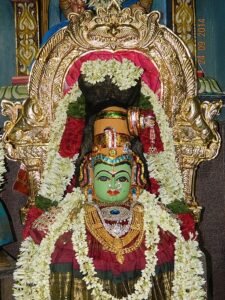
Meenakshi Temple – Madurai
The Meenakshi Temple in Madurai is a remarkable symbol of South Indian architecture and spiritual devotion. Dedicated to Goddess Meenakshi, it attracts around 20,000 visitors daily to its sprawling complex, which includes two principal sanctuaries and numerous shrines. Enclosed by imposing walls, the temple features a mesmerizing blend of indoor and outdoor spaces, adorned with around 30,000 sculptures, offering visitors a captivating spiritual experience. The Meenakshi Temple attracts around 20,000 visitors daily to its sprawling 700,000 square feet of space, housing two principal sanctuaries and numerous shrines of diverse sizes.
Namaste 🙏 नमस्ते
Secure your visit • अपनी यात्रा सुरक्षित करें
Historical background and Architectural splendor
The Meenakshi Temple, with roots dating to the 1st century C.E, was reportedly built by Kulashekarar Pandyan, a ruler of the Pandyan dynasty, following divine instructions from Lord Shiva in a dream. Ancient texts from the 1st to the 4th century C.E describe it as the city’s central structure, while records from the early 6th century note its role as a hub for scholarly discussions. The temple underwent reconstruction in the 16th century after destruction by Muslim invaders.
In the 14th century C.E, Malik Kafur of the Delhi Sultanate pillaged the Meenakshi Temple, leading to restoration during the Vijayanagara Empire’s rule. Vishwanatha Nayakar expanded it in the late 16th and early 17th centuries following the ‘Silpa Shastras.’ Thirumalai Nayak, reigning from 1623 to 1655, added pillared halls, and subsequent Nayaka rulers continued expansion until the British East India Company era, causing degradation. Restoration began in 1959 by Tamil Hindus, with collaboration from historians and engineers, completed in 1995, preserving the Meenakshi Temple’s cultural and architectural grandeur.
The Meenakshi Amman Temple complex stands as a testament to the zenith of Dravidian architecture, a style characterized by its towering gopurams, intricate sculptures, and vibrant colors. Each facet of this architectural masterpiece tells a story of devotion, skill, and artistic brilliance.
At the forefront of the temple’s architectural splendor are the 14 majestic gopurams that punctuate the skyline of Madurai. These towering gateways, ranging from 100 to 170 feet in height, are not merely entrances but symbols of divine transcendence. Each gopuram is an intricately carved masterpiece, its surface adorned with a pantheon of gods, goddesses, celestial beings, and mythological creatures. Every detail of these sculptures, from the graceful poses to the ornate jewelry, reveals the unparalleled craftsmanship of the artisans who brought them to life. As one stands before these colossal structures, a profound sense of awe and reverence engulfs the observer, transporting them to a realm where the sacred and the artistic converge in a harmonious celebration of spirituality.


Religious Significance
In this temple, Goddess Meenakshi is depicted holding a parrot in her right hand, and it is believed to be one of the five places where Shiva performed the tandava. The shrine also features a sizable silver statue of Lord Shiva in the form of Nataraja, showcasing a unique dance pose with his right leg raised, setting it apart from the conventional portrayal with the left leg raised.
Annually, in April, the grand celebration of "Meenakshi Thirukalyanam," symbolizing the divine marriage of Meenakshi, takes place with enthusiasm. This month-long festival, known as the Madurai Vivah, features events such as the Rath Festival and Float Utsav, alongside the observance of Navratri and Shivratri.
Festival and Celebrations
The Meenakshi Temple is renowned for its grand and vibrant festivals, which reflect the rich cultural and spiritual heritage of Madurai. The most prominent celebration is the Meenakshi Thirukalyanam, or the Celestial Wedding, where the divine marriage of Goddess Meenakshi and Lord Sundareswarar is reenacted with great devotion, attracting thousands of pilgrims from across the country. Equally magnificent is the Chithirai Festival, a month-long event filled with processions, rituals, music, and traditional performances, making it one of South India’s largest religious festivals. The temple also celebrates Navaratri with beautifully decorated golu displays and special pujas, while the spectacular Float Festival (Teppam) sees the idols placed on a decorated raft and taken around the Mariamman Teppakulam tank amid lights and music.
Other significant festivals include Avani Moola Utsavam, known for its ritual enactments of Lord Shiva’s sacred stories; Aadi Pooram, honoring the divine feminine energy; and Panguni Uthiram, a festival linked to sacred marriages of deities. The temple also hosts the Masi Mandala Festival, Aavani Moolam, and Thai Poosam, each marked by unique rituals, colorful traditions, and deep spiritual significance. Together, these celebrations make Meenakshi Temple a vibrant center of devotion, culture, and centuries-old heritage.
Surroundings area & attractions
- Thirumalai Nayak Palace: A historical palace known for its architectural grandeur, located near the Meenakshi Temple.
- Alagar Kovil (Alagar Temple): Situated atop the Alagar Hills, this temple dedicated to Lord Alagar offers panoramic views of the surrounding landscape.
- Vandiyur Mariamman Teppakulam: A large temple tank with a mandapam in the center, known for the float festival and its cultural significance.
- Koodal Azhagar Temple: An ancient temple dedicated to Lord Vishnu, known for its architectural beauty and intricate carvings
- Thiruparankundram Murugan Temple: One of the six abodes of Lord Murugan, located on a hill, offering a panoramic view of Madurai.
- Goripalayam Dargah: A revered Muslim shrine in Madurai known for its spiritual significance.
- Yanaimalai: A hillock known for its Jain caves, offering a glimpse into the historical Jain influence in the region.
Visitor information
Entry Fee: No fee
Timings :
- 5 AM to 12.30 PM
- 4 PM to 9.30 PM
When going for darshan at Meenakshi Temple, make a plan for at least two three hours for a relaxed exploration of the temple and darshan of the deity. During the festival, it takes around 4 to 5 hours to get darshan.
Address:
Meenakshi Amman Temple, Madurai Main, Madurai, Tamil Nadu 625001, India
Dress Code
- Male devotees are required to wear dhotis or pyjamas with an upper cloth, or formal pants and shirts.
- Women are expected to don sarees or half sarees with blouses, or churidhars with an upper cloth when visiting the temple.
Notable Events and Incidents
- Consecration of the Temple : 7th century.
- Vijayanagara Empire Contributions: 14th-17th Century
- Meenakshi Thirukalyanam (Annual Event)
- Temple Tower Collapse: 2016
- Religious and Cultural Festivals
Connectivity:
- By Air: The nearest airport to the Meenakshi Temple is Madurai International Airport, located about 12 kilometers away. From the airport, visitors can hire taxis, autos, or app-based cabs to reach the temple conveniently.
- By Rail: The closest railway station is Madurai Junction, situated approximately 1.5 kilometers from the temple. The station is well-connected to major Indian cities, and local transport like autos, taxis, and buses are easily available to reach the temple.
- By Road: Madurai is well-linked by road to major cities across Tamil Nadu and neighboring states. The temple can be accessed smoothly through city buses, autos, taxis, and app-based cabs, with direct routes leading to the vibrant Meenakshi Amman Temple area
FAQ
The Meenakshi Amman Temple is located in the city of Madurai, Tamil Nadu, India.
The presiding deities of the Meenakshi Amman Temple are Goddess Meenakshi (Parvati) and Lord Sundareswarar (Shiva).
The Meenakshi Amman Temple is one of the most prominent and significant temples in South India, dedicated to Goddess Meenakshi, who is considered the divine consort of Lord Shiva. It is known for its architectural grandeur, spiritual significance, and rich cultural heritage.
The Meenakshi Amman Temple has a long and storied history, dating back over several centuries. It is believed to have been originally built by the Pandyan dynasty kings, with subsequent renovations and expansions carried out by various rulers and patrons.
The Meenakshi Amman Temple is renowned for its exquisite Dravidian architecture, characterized by towering gopurams (gateway towers) adorned with intricate sculptures and carvings depicting various deities, mythological scenes, and celestial beings.
The Meenakshi Amman Temple follows a strict schedule of daily rituals and ceremonies, including puja (worship), abhishekam (ritual bathing of the deities), aarti (ritual of worship with lamps), and special festivities during auspicious occasions and festivals.
The Meenakshi Amman Temple celebrates several festivals with great pomp and fervor, including Meenakshi Thirukalyanam (the divine marriage ceremony of Meenakshi and Sundareswarar), Chithirai Thiruvizha (Tamil New Year), and Navratri.
Yes, visitors are allowed to explore the entire temple complex of Meenakshi Amman Temple, including its various shrines, mandapas (pavilions), corridors, and surrounding precincts. However, certain areas may have restricted access during specific rituals or ceremonies.
While there is no strict dress code, visitors are expected to dress modestly and respectfully while visiting the Meenakshi Amman Temple.
Madurai is home to several other attractions, including the Thirumalai Nayakkar Mahal, Gandhi Memorial Museum, and Vandiyur Mariamman Teppakulam (tank). Visitors can also explore the vibrant markets and cultural landmarks of the city.
According to legend, Goddess Meenakshi, an incarnation of Goddess Parvati, was born with three breasts and was destined to marry Lord Sundareswarar (Shiva) of Madurai. The third breast disappeared upon meeting Lord Shiva, signifying the fulfillment of her destiny.
The Meenakshi Amman Temple boasts 14 majestic gopurams, each adorned with intricate sculptures and carvings. These gopurams serve as symbolic gateways leading devotees into the sacred space of the temple complex.
The Thousand Pillar Mandapam is a prominent feature of the Meenakshi Amman Temple, known for its exquisite architecture and intricate stone carvings. It houses numerous pillars adorned with sculptural motifs, creating a mesmerizing visual spectacle for visitors.
Yes, the Meenakshi Amman Temple complex features several sacred tanks or water bodies, including the Potramarai Kulam (Golden Lotus Tank) and the Vandiyur Mariamman Teppakulam (tank), where various rituals and festivities take place.
The golden top of the sanctum sanctorum (Vimana) of the Meenakshi Amman Temple is adorned with intricate gold-plated sculptures and represents the pinnacle of divine energy and spiritual attainment.
Yes, devotees have the opportunity to offer special prayers, conduct rituals, and make vows (mannat) at the Meenakshi Amman Temple for various purposes, including seeking blessings for good health, prosperity, success, and spiritual enlightenment.
The prakarams and mandapams within the Meenakshi Amman Temple complex serve as spaces for devotees to circumambulate, meditate, and participate in religious ceremonies. Each corridor and hall has its own unique architectural and spiritual significance.
The Meenakshi Amman Temple authorities undertake efforts to preserve and maintain the architectural heritage of the temple, including regular maintenance, restoration work, and documentation of historical features to ensure the temple’s longevity and cultural significance.
Yes, visitors to the Meenakshi Amman Temple can avail themselves of guided tours conducted by knowledgeable temple guides.
Yes, there are several accommodation options available for pilgrims and tourists near the Meenakshi Amman Temple, including hotels, guesthouses, and dharmashalas (pilgrims’ rest houses), catering to various budgets and preferences.
